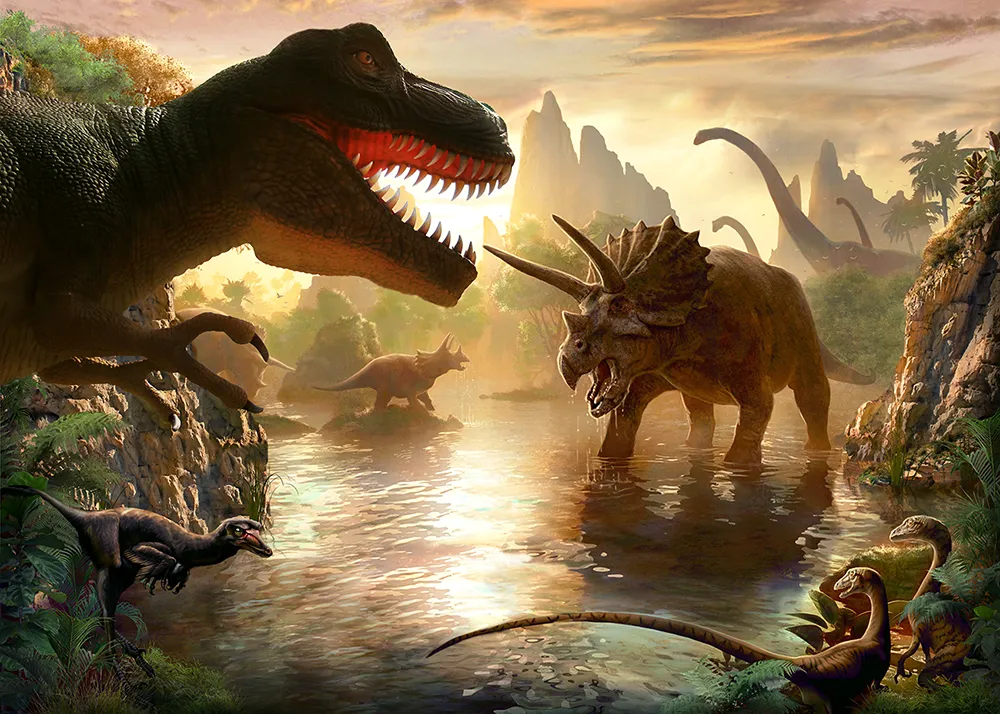Dinosaurs are among the most fascinating and diverse groups of animals to have ever roamed the Earth. Their evolution spanned over 160 million years, from their emergence in the Triassic period to their eventual extinction at the end of the Cretaceous period. The story of dinosaur evolution is one of gradual change, adaptation, and diversification that gave rise to the variety of species we recognize today. Understanding how dinosaurs evolved over time involves exploring the origins of their ancestors, key evolutionary milestones, and the environmental factors that shaped their development.
The Origins of Dinosaurs
Dinosaurs first appeared during the Triassic period, around 230 million years ago, a time when the Earth’s continents were grouped together in a supercontinent called Pangaea. At this point in history, life on Earth was dominated by reptiles, and the first dinosaurs evolved from small, bipedal reptiles known as archosaurs. Archosaurs were part of a larger group of reptiles that included crocodiles and birds. They had certain characteristics that made them successful, such as an upright posture (legs positioned directly under the body), which allowed for more efficient movement compared to sprawling reptiles.
The earliest dinosaurs were relatively small, carnivorous creatures that lived in a world still dominated by larger reptiles like flying pterosaurs and large marine reptiles. These first dinosaurs were agile, fast, and had a strong advantage over many of their contemporaries. Over time, they began to diversify, leading to the vast array of dinosaur species that would follow.
The Rise of the “Big Three” Dinosaur Groups
By the late Triassic period, dinosaur evolution began to accelerate, leading to the emergence of the major groups of dinosaurs we know today. These groups are:
- Saurischia (Lizard-hipped dinosaurs): This group includes both the massive herbivorous sauropods, such as Apatosaurus and Brachiosaurus, and the carnivorous theropods, like Tyrannosaurus rex and Velociraptor. The defining feature of the Saurischia is their hip structure, which had a lizard-like arrangement of bones.
- Ornithischia (Bird-hipped dinosaurs): Although the “bird-hipped” label may seem misleading (since they aren’t directly related to modern birds), these dinosaurs had a pelvic structure that was different from that of lizard-hipped dinosaurs. The group includes herbivorous species such as Stegosaurus, Triceratops, and the duck-billed Hadrosaurus.
- Pterosaurs: While not technically dinosaurs, pterosaurs were close relatives and evolved along with them. These flying reptiles included species like Pteranodon and Pterodaustro.
The Jurassic Period: A Time of Growth and Diversification
The Jurassic period (about 201 to 145 million years ago) was a pivotal time for dinosaur evolution, marked by significant diversification and the rise of many iconic species. During this period, dinosaurs began to grow larger, and many of the major groups of dinosaurs reached their peak in terms of size and variety. The environment of the Jurassic was warm and humid, with lush forests and an abundance of plant life, which provided ample food for herbivores, supporting the growth of giant plant-eating dinosaurs.
Sauropods, the long-necked, plant-eating giants like Brachiosaurus and Diplodocus, became dominant in the Jurassic. These massive creatures were able to feed on the high tree canopies, which allowed them to thrive in the vegetation-rich environments.
Meanwhile, the theropods continued to evolve, with species such as Allosaurus becoming large predators at the top of the food chain. This period also saw the emergence of early bird-like dinosaurs, with Archaeopteryx serving as one of the first creatures to show a combination of dinosaur and bird-like features, such as feathers.
The Cretaceous Period: Innovation and Extinction
The Cretaceous period (about 145 to 66 million years ago) saw further diversification and the rise of some of the most famous dinosaurs, including Tyrannosaurus rex, Triceratops, and Velociraptor. By this time, the Earth’s climate had changed, and the continents had drifted apart, creating new environments and ecosystems. This separation allowed for the isolation of species, resulting in evolutionary innovations and adaptations.
The theropod lineage, in particular, became more diverse, with species like Tyrannosaurus rex reaching the apex of carnivorous evolution, while other species, like Velociraptor, remained smaller but highly specialized for hunting in packs. The Ornithischians also flourished, with herbivores like Hadrosaurids (duck-billed dinosaurs) and Ceratopsians (like Triceratops) evolving to fill different ecological niches.
In the Cretaceous, dinosaurs began to evolve more specialized traits. For example, some theropods developed feathers, possibly for temperature regulation, display, or even flight, marking an important evolutionary step toward the modern birds. The diversity of plant-eating dinosaurs also grew as angiosperms (flowering plants) began to appear, providing new food sources and contributing to the evolution of herbivores.
Extinction and the End of the Dinosaur Era
The end-Cretaceous extinction event about 66 million years ago marked the end of the dinosaurs’ reign on Earth. This event, most likely caused by the impact of a large asteroid and massive volcanic activity, led to dramatic climate changes that wiped out nearly 75% of Earth’s species, including the non-avian dinosaurs. While most dinosaurs went extinct, their avian relatives (birds) survived and evolved into the wide variety of species we see today.
Key Evolutionary Trends in Dinosaurs
Throughout their evolution, dinosaurs exhibited several important trends:
- Size Increase: Many dinosaur groups, especially sauropods and theropods, evolved into giant forms over millions of years. This increase in size was likely driven by evolutionary pressures such as predation, environmental opportunities, and competition for resources.
- Bipedalism: Dinosaurs, especially theropods, were bipedal, which allowed for faster movement and greater predatory efficiency. Over time, many species of theropods became increasingly specialized for bipedal hunting.
- Feathers and Flight: Some theropods evolved feathers, a trait that eventually gave rise to modern birds. This innovation allowed dinosaurs to exploit new ecological niches, and the first flightless birds emerged by the late Cretaceous period.
- Specialization: Dinosaurs adapted to a wide range of environments, leading to the evolution of specialized forms. Herbivorous dinosaurs developed complex teeth and chewing mechanisms, while carnivores developed sharp claws and teeth for hunting.

Conclusion
Dinosaurs evolved over a vast span of time, from small, agile predators to towering giants, occupying nearly every ecological niche on the planet. Their evolution was shaped by numerous factors, including environmental changes, competition, and predation. The evolutionary success of dinosaurs can be attributed to their remarkable adaptability and the way they responded to changes in their surroundings. While the extinction event at the end of the Cretaceous period brought an end to the non-avian dinosaurs, their legacy lives on through modern birds, the only living descendants of this once-dominant group of animals.



